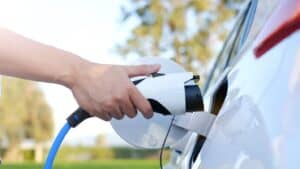Louie Valdez of Thousand Oaks CA: The Impact of Autonomous Electric Vehicles: How Driverless EVs Are Redefining Transportation
As the transportation industry evolves, one of the most exciting innovations on the horizon is the development of autonomous electric vehicles (AEVs). These vehicles promise to revolutionize the way we travel, offering not only eco-friendly transportation but also enhanced safety, efficiency, and convenience. Experts such as Louie Valdez of Thousand Oaks, CA, are at the forefront of this transition, providing insights into how these vehicles will reshape the future of personal mobility. By integrating self-driving technology with electric power, AEVs have the potential to reduce carbon emissions, improve traffic flow, and create safer roads, all while offering a more seamless driving experience.
The Integration of Electric and Autonomous Technologies
The combination of electric and autonomous technologies in vehicles represents a monumental shift in the automotive industry. Electric vehicles (EVs) have already made significant strides in reducing the carbon footprint of transportation by replacing traditional gasoline-powered cars with cleaner alternatives. However, when paired with autonomous driving capabilities, these vehicles become even more transformative. Driverless technology, which relies on sensors, cameras, and advanced algorithms to navigate the road without human intervention, can significantly enhance the efficiency of EVs. Experts like Louie Valdez of Thousand Oaks, CA, have been exploring the potential of this integration, highlighting its role in optimizing both energy consumption and vehicle performance.
Autonomous electric vehicles are not just about eliminating the need for drivers; they are also about creating more intelligent systems that can anticipate traffic patterns, adjust driving speeds, and optimize energy usage. For instance, AEVs can potentially communicate with one another, reducing the need for stop-and-go driving, which is a major factor in energy consumption. With fewer energy-draining stops and starts, these vehicles would use less electricity and reduce the overall carbon footprint of transportation.
How Autonomous Electric Vehicles Are Improving Safety
Safety is another area where autonomous electric vehicles stand to make a profound impact. Traditional vehicles rely heavily on human drivers, whose decisions can be affected by distractions, fatigue, or poor judgment. Autonomous driving systems, on the other hand, are designed to follow the rules of the road, react faster than humans, and make more consistent decisions based on real-time data. According to experts, such as Louie Valdez of Thousand Oaks, CA, these vehicles could significantly reduce the number of accidents caused by human error, which is responsible for the majority of traffic fatalities today.
Autonomous vehicles are equipped with an array of sensors, including LIDAR, radar, and cameras, that allow them to detect objects, pedestrians, and other vehicles from long distances. These sensors work together to create a 360-degree view of the vehicle’s surroundings, enabling the car to respond to potential hazards long before a human driver could. Additionally, autonomous EVs can be programmed to follow a defensive driving protocol, ensuring that they always maintain a safe distance from other vehicles, react to sudden changes in traffic conditions, and adhere to speed limits.
The combination of electric and autonomous technologies enhances this safety even further. Electric vehicles, by nature, are quieter than gasoline-powered cars, reducing the likelihood of accidents involving pedestrians or cyclists who may not hear the vehicle approaching. Moreover, the instant torque provided by electric motors allows AEVs to accelerate smoothly and predictably, avoiding sudden jerks or jolts that could cause a collision.
The Environmental Impact of Autonomous Electric Vehicles
One of the most compelling reasons for the push toward autonomous electric vehicles is their potential to reduce the environmental impact of transportation. The environmental benefits of electric vehicles are well-documented—by eliminating the need for fossil fuels, EVs help reduce harmful emissions that contribute to air pollution and climate change. However, when combined with autonomous driving technology, these vehicles can further reduce their ecological footprint.
AEVs are capable of optimizing their energy use by employing smart driving techniques that minimize fuel consumption. For example, AEVs can take the most efficient routes, avoid congested areas, and adjust their driving speed according to real-time conditions. This not only saves energy but also reduces traffic congestion, which is a major contributor to pollution. As experts like Louie Valdez of Thousand Oaks, CA, point out, fewer cars idling in traffic means fewer emissions and a more sustainable transportation system.
Furthermore, the widespread adoption of autonomous electric vehicles could significantly reduce the overall demand for cars. As AEVs become more efficient and cost-effective, the need for personal car ownership may diminish, as people can opt to share rides through autonomous fleets. This would lead to fewer vehicles on the road, reducing both traffic and the environmental impact associated with car manufacturing, parking, and maintenance.
The Economic Implications of Autonomous Electric Vehicles
The introduction of autonomous electric vehicles will not only have an environmental and safety impact but also a significant economic one. The rise of AEVs could create new job opportunities in industries such as AI, robotics, and battery technology. At the same time, it could also render certain jobs obsolete, particularly those involving driving. While this may initially raise concerns about job displacement, experts like Louie Valdez of Thousand Oaks, CA, argue that the transition to AEVs will ultimately lead to the creation of new, highly skilled jobs in emerging sectors.
Moreover, the cost of transportation could decrease with the widespread adoption of autonomous EVs. For example, individuals may be able to access transportation as a service, paying for rides on-demand rather than purchasing and maintaining their own vehicles. This model could be particularly beneficial for urban areas where car ownership is expensive and impractical. By reducing the costs of personal car ownership, AEVs could democratize access to transportation, making it more affordable and accessible for everyone.
The Challenges Facing Autonomous Electric Vehicles
Despite the many advantages of autonomous electric vehicles, there are several challenges to overcome before they can become mainstream. One of the biggest hurdles is the development of reliable and robust autonomous driving systems. While AEVs have shown great promise in controlled environments, real-world driving conditions are much more complex. The ability to navigate through unpredictable weather, construction zones, or areas with sparse infrastructure remains a challenge.
Additionally, regulatory and legal frameworks for autonomous vehicles are still in the early stages. Governments and regulators around the world must create policies that address issues such as liability in the event of an accident, insurance requirements, and cybersecurity concerns. Experts like Louie Valdez of Thousand Oaks, CA, emphasize the importance of creating these frameworks to ensure the safe and ethical deployment of AEVs on public roads.
Another challenge lies in the infrastructure needed to support autonomous electric vehicles. This includes not only charging stations but also the development of smart city infrastructure that can communicate with autonomous vehicles. This might involve implementing vehicle-to-infrastructure (V2I) communication systems that allow AEVs to interact with traffic lights, road signs, and other infrastructure to enhance their driving capabilities.
A Roadmap to the Future of Autonomous Electric Vehicles
Looking ahead, the future of autonomous electric vehicles appears promising. As technology continues to improve, AEVs will become safer, more efficient, and more accessible. Experts like Louie Valdez of Thousand Oaks, CA, believe that the widespread adoption of AEVs could lead to a transportation revolution, creating a safer, more sustainable, and more cost-effective system for people around the world.
The integration of autonomous technology with electric vehicles represents a key step toward reducing the environmental impact of transportation and achieving sustainability goals. While challenges remain, the ongoing advancements in autonomous driving and EV technology are paving the way for a future where transportation is cleaner, safer, and more efficient.
In conclusion, as the automotive industry continues to embrace autonomous electric vehicles, experts like Louie Valdez of Thousand Oaks, CA, will play an integral role in shaping the future of mobility. By addressing the technical, economic, and regulatory challenges, we can look forward to a world where driverless EVs redefine the way we travel, contributing to a cleaner, safer, and more connected global transportation system.


